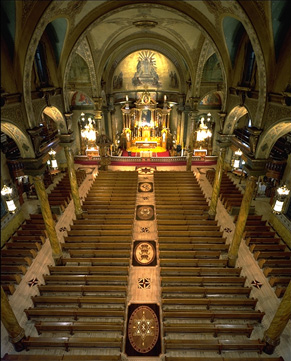 Many . . . visitors stand in awe at the 203-foot long edifice. With seating for 2,000 visitors, the church is larger than Chicago’s Holy Name Cathedral. But in contrast to the nearly stripped-bare cathedral, one’s attention at St. John’s is immediately focused on the sanctuary, adorned for a King. And the King in His tabernacle reigns from the center of the high altar.
Many . . . visitors stand in awe at the 203-foot long edifice. With seating for 2,000 visitors, the church is larger than Chicago’s Holy Name Cathedral. But in contrast to the nearly stripped-bare cathedral, one’s attention at St. John’s is immediately focused on the sanctuary, adorned for a King. And the King in His tabernacle reigns from the center of the high altar.— John Burger, A Rennaissance in Chicago
At St. John Cantius Parish in Chicago, Illinois, the Mass is celebrated both in the old form and in the new form in Latin and English. The Reverand. Dennis Kolinski, S.J.C., is an associate pastor at St. John Cantius.
Excerpts from One Rite, Two Forms: The Liturgical Life of St. John Cantius :Sacred Music Interviews Fr. Dennis Kolinski, S.J.C., Sacred Music, Fall 2007:
SM: Many people who attend the old Mass and the new observe few connections between them.
Kolinski: And this is where the music really does make the difference. This is the key aesthetic bridge between the two forms. In a larger sense, the bridge is the Church’s tradition, of which the music is part. If you want to see a true Vatican II parish, come to St. John Cantius, where the actual instruction from the Council is being carried out. Here we have always looked to the future that we are beginning to see coming to fruition today, a future in which chant is the music of the Catholic liturgy.
. . .
SM: How do parishioners respond to the liturgical differences between the forms?
Kolinski: In the early days, we had parishioners who would come only to the old form and others who would come to the new form. But not everyone is focused on the differences. I can recall one young man born long after the Council who showed up to the 11:00am Mass, which is the Latin normative Mass from the Missal of 1970. He was swept up in the beauty, and thought it was Heaven. Excitedly, he told one of the brothers after Mass: “I will never go to another Novus Ordo Mass!”
SM: Did the Brother tell him that he had just attended a Novus Ordo Mass?
Kolinski: He didn’t have the heart to tell him.
SM: So today, most people don’t focus on the differences.
Kolinski: There are a few, but most people choose their Mass based on the time of day that is convenient for them. It’s true that the 1970 Missal did not grow organically from what preceded it in a manner that it should have. And yet what’s really been interesting to us, and very heartening, is that most of the old traditionalists will now attend Mass in the new form. And that includes most of the parishioners who used to attend the St. Pius X chapel. Now, they come to the Novus Ordo and receive communion and just avail themselves to the sacraments in every way. They might still prefer the traditional Roman Rite, to which they have a right, but there is a lot of crossover.
SM: One of the main worries about liberalizing the old Mass was that doing so would be divisive. But that isn’t your experience.
Kolinski: Precisely, and those who level that criticism haven’t typically experienced what we do here. They just don’t know what they are talking about.
. . .
SM: Are all your Masses said ad orientem?
Kolinski: For five years now, that has been true. No one complained. In fact, people love it. In the same way, parishioners want to receive communion at the rail. If someone wants to stand, we permit it, but, for the most part, people prefer kneeling.
